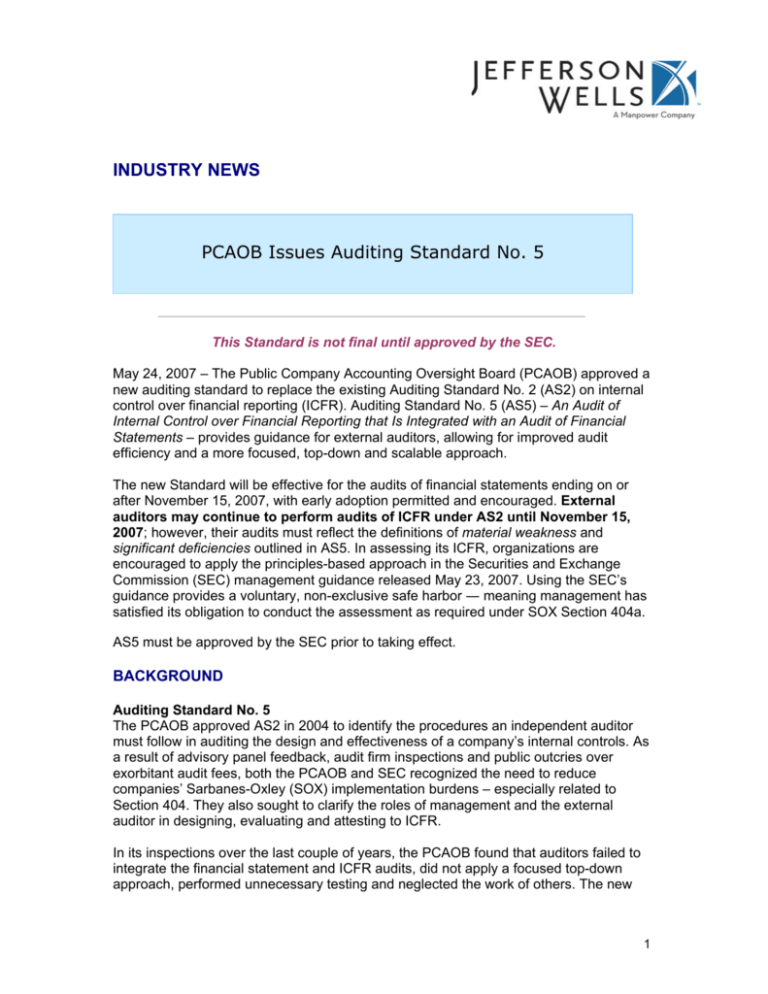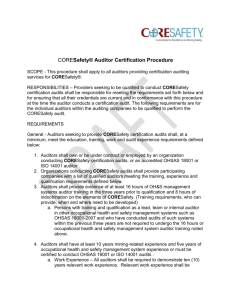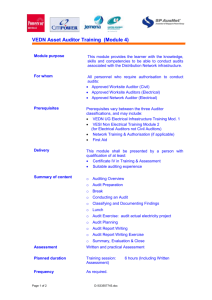INDUSTRY NEWS PCAOB Issues Auditing Standard No. 5
advertisement

INDUSTRY NEWS PCAOB Issues Auditing Standard No. 5 ___________________________________________________ This Standard is not final until approved by the SEC. May 24, 2007 – The Public Company Accounting Oversight Board (PCAOB) approved a new auditing standard to replace the existing Auditing Standard No. 2 (AS2) on internal control over financial reporting (ICFR). Auditing Standard No. 5 (AS5) – An Audit of Internal Control over Financial Reporting that Is Integrated with an Audit of Financial Statements – provides guidance for external auditors, allowing for improved audit efficiency and a more focused, top-down and scalable approach. The new Standard will be effective for the audits of financial statements ending on or after November 15, 2007, with early adoption permitted and encouraged. External auditors may continue to perform audits of ICFR under AS2 until November 15, 2007; however, their audits must reflect the definitions of material weakness and significant deficiencies outlined in AS5. In assessing its ICFR, organizations are encouraged to apply the principles-based approach in the Securities and Exchange Commission (SEC) management guidance released May 23, 2007. Using the SEC’s guidance provides a voluntary, non-exclusive safe harbor ― meaning management has satisfied its obligation to conduct the assessment as required under SOX Section 404a. AS5 must be approved by the SEC prior to taking effect. BACKGROUND Auditing Standard No. 5 The PCAOB approved AS2 in 2004 to identify the procedures an independent auditor must follow in auditing the design and effectiveness of a company’s internal controls. As a result of advisory panel feedback, audit firm inspections and public outcries over exorbitant audit fees, both the PCAOB and SEC recognized the need to reduce companies’ Sarbanes-Oxley (SOX) implementation burdens – especially related to Section 404. They also sought to clarify the roles of management and the external auditor in designing, evaluating and attesting to ICFR. In its inspections over the last couple of years, the PCAOB found that auditors failed to integrate the financial statement and ICFR audits, did not apply a focused top-down approach, performed unnecessary testing and neglected the work of others. The new 1 Standard focuses external auditors on the most important matters, eliminates unnecessary procedures, incorporates guidance on efficiency, provides explicit and practical guidance on scaling the audit to fit the complexity of the company, and creates a simplified Standard. It also eliminates the external auditor’s evaluation of management’s assessment of ICFR and encourages the use of others’ work. In addition, the definition of material weakness was modified to replace the phrase “more than remote” with “reasonable possibility.” KEY POINTS Auditing Standard No. 5 Focus the audit of internal control over financial reporting on the most important matters A significant change from the proposal, AS5 eliminates the requirement that the auditor must perform a walk-through for each significant process before selecting controls to test. This allows the auditor to select appropriate procedures based on the risk to financial statement assertions. Using this assessment, the auditor selects the controls to test and the procedures to use based on the risk of a material weakness. AS5 articulates a key principle ― that a direct relationship exists between the risk of material weakness and the amount of auditor attention given to that area. It requires auditors to use a top-down approach, beginning with the financial statements and entity-level controls, and linking them to significant accounts and assertions. Specifically, AS5 creates a mandatory obligation for auditors, stating the auditor “should” use a top-down approach, while retaining flexibility in performing the specific procedures. AS5 emphasizes integrating the financial statement audit with the audit of ICFR. Clearly, procedures performed for the audit of financial statements should influence the risk assessment and the nature, extent and timing of testing performed in the audit of ICFR and vice versa. For example, the results of tests performed on specific accounts and balances in the financial statement audit should be considered by the auditor in completing the risk assessment regarding the controls over the same accounts and disclosures. In addition, AS5 explicitly calls for the auditor to apply the same materiality thresholds for the annual audit of financial statements to the audit of ICFR. The new Standard continues to instruct auditors to evaluate deficiencies in light of interim materiality assessments. With respect to multiple-location testing, the AS5 eliminates AS2’s three categories of locations and the guidance related to the testing of those locations. AS5 applies the same risk framework to the scoping of sites to test, instructing auditors to use a top-down approach when scoping the work at an organization’s various locations. Provide explicit and practical guidance on scaling the audit to fit the complexity of the company or operation AS5 does not create a separate standard for smaller companies. Instead, it requires the auditor to tailor the nature, extent and timing of testing to meet the 2 unique characteristics of the company, business unit or process. The Standard identifies the unique characteristics of less complex business units or processes and throughout the guidance identifies specific points to tailor the audit based on the auditor’s assessment of complexity. According to the Standard, “Scaling is most effective as a natural extension of the risk-based approach and applicable to the audits of all companies.” According to Thomas Ray, the PCAOB’s chief auditor, the PCAOB is undertaking a separate initiative to streamline audits of smaller companies. A task force representing 12 registered public accounting firms drafted an audit guide for smaller companies. This guidance will provide additional detail on tailoring the audit for less complex entities. Eliminate procedures that are unnecessary to achieve the intended benefits AS5 links the testing of specific controls to the risk assessment of those controls. This means the risk that a specific control is ineffective should drive the nature, extent and timing of testing performed and evidence of effectiveness obtained for that control. As risk increases, the volume and type of evidence the auditor should obtain should also increase. Mirroring the SEC’s guidance to issuers, auditors need not conduct additional tests if entity-level controls or combinations of controls adequately mitigate the risk of material misstatement. AS5 points out that automated controls are generally lower risk if general IT controls are effective. The new Standard allows the auditor to apply the same risk framework to IT controls, thereby further reducing potential costs to comply. Using an approach such as the Institute of Internal Auditor’s Guide to the Assessment of IT General Controls Scope Based on Risk (GAIT), organizations can identify those applications and controls that tie directly to a financial statement assertion and avoid unnecessary work. Finally, the new Standard allows auditors to use knowledge gained in previous years’ testing in evaluating the risk related to a specific control. As a result, auditors should modify their risk assessments for specific controls on the basis of prior years’ findings and adjust the nature, extent and timing of testing to reflect the updated risk assessment. AS5 removes the language that each year’s audit must stand on its own. Instead, when evaluating the risk and related testing required in the current year, it directs the auditor to consider the nature, extent and timing of testing performed in prior years, the results of that testing, and any changes in the control from the prior year. PCAOB members noted that this does not open the door for rotational testing, but allows auditors to adjust the nature, extent and timing of significant controls testing. Require auditors to consider whether and how to use the work of others AS5 encourages external auditors to maximize use of testing completed by management, the internal audit function and third parties, when evaluating internal controls. The new Standard will refer to existing AU 322 as the framework auditors should use in determining whether to use the work of others. The PCAOB staff views the evaluation of the work of others as occurring on a continuum rather than an “on/off switch” ― so as the competence and objectivity of the individual performing the procedures increases, so does the evaluation of 3 that work. AS5 prompts the auditor to understand the relevant activities taken by management and others, and use that understanding to alter the nature, extent and timing of testing. To optimize the effectiveness of this provision, the new Standard eliminates AS2’s principal evidence provision, which required the auditor’s work to provide the principal evidence for the auditor’s opinion. Incorporate guidance on efficiency AS5 contains many of the audit efficiency practices outlined in the May 16, 2005, guidance and other literature, including the language regarding baselining IT controls. As a result, companies should realize reduced compliance costs on a year-over-year basis. A simplified standard AS5 changes the definition of material weakness from “more than remote likelihood” to “reasonable possibility.” In addition, AS5 defines significant deficiency as “less severe than a material weakness yet merits the attention of those responsible for the oversight of the company’s financial reporting.” In other words, significant deficiencies are not necessarily material weaknesses; rather they are items on which the audit committee should be informed. According to the PCAOB staff, this requires a subjective judgment by the auditor. The PCAOB hopes to reduce the scope of efforts by focusing auditors on detecting material weaknesses. Finally, the PCAOB clarified that an internal control audit is limited to an evaluation of whether, in the auditor’s opinion, the company’s internal control is effective. It does not include an opinion regarding the adequacy of management’s process to reach its conclusion. This clarification mirrors the proposed changes to Regulation S-X, eliminating the requirement that an issuer obtain an opinion on both its internal control over financial reporting and management’s assessment. This would end the practice of external auditors performing specific procedures to evaluate management’s assessment. IMPACT TO CLIENTS The SEC and PCAOB continue to push issuers and external auditors to approach SOX Section 404 using a top-down approach. Accelerated and nonaccelerated filers have the opportunity to review and improve their entity-level controls and risk management processes to reduce compliance costs. In addition, by working with the external audit firm to incorporate this guidance into the audit scope, companies can focus on fewer key controls and reduce related testing, resulting in lower direct compliance costs. Organizations will reap the business benefits that come with improved risk management, including loss reduction, improved credit ratings and enhanced overall organizational performance. Non-accelerated filers are required to furnish management’s assessment for fiscal years ending on or after December 15, 2007, with the initial auditor’s report due for fiscal years ending on or after December 15, 2008. Non-accelerated filers should begin to implement a risk assessment process and entity-level controls that positively impact the auditor’s risk assessment. Focusing on key controls will ensure that related testing is streamlined and efficient. Both the SEC guidance and AS5 allow management to choose a framework for designing and 4 documenting its risks and controls, companies can work on these processes without fearing they might have to reinvest in redesigning and re-documenting controls and processes at a future date. To support the implementation of SOX, non-accelerated filers need to remediate identified, ineffective controls and strengthen or create an internal audit function that enhances the effectiveness of the entity-level controls and the organization’s risk assessment. Prudent organizations will systematically prepare for the Section 404 implementation deadlines by building efficiency and sustainability into the compliance process. Under the new Standard, external auditors are encouraged to more fully integrate audits of financial statements and audits of ICFR. Internal control audits should use the same annual materiality determinations as financial statement audits. Auditors will be able to increase the use of management’s assessment of key risks and controls to the extent the audit of internal controls aligns with that assessment. Ongoing, effective dialogue between management and external auditors should result in a better-focused, more efficient SOX effort. Companies should consider the quality and objectivity of the work performed by management and the internal audit function, strengthening the quality and objectivity of that work. External auditors’ increased use of the work of others creates an opportunity for companies to reduce the cost of compliance by transferring testing and other work from the external auditors to qualified internal audit staff and other resources. HOW JEFFERSON WELLS CAN HELP Experienced Jefferson Wells professionals deliver services in internal audit and controls, technology risk management, tax, and finance and accounting. Our expertise includes helping clients identify, mitigate and manage risk across the finance function. The Jefferson Wells Sustaining Internal Control Compliance and SOX 404 for Nonaccelerated Filers methodology provide a structure for reducing and streamlining controls. We perform sustainability assessments, including broad compliance process reviews tailored to a client’s risk environment, leading to a sustainable and cost-effective governance structure. We also provide practical implementation support to realize the desired improvements. We serve clients, including Fortune 500 and Global 1000 companies, through highly experienced, salaried professionals working from offices across North America and Europe. For additional information, please contact your local Jefferson Wells Business Development Manager. 5







